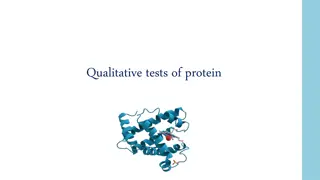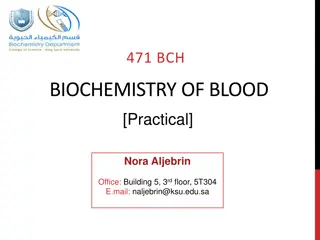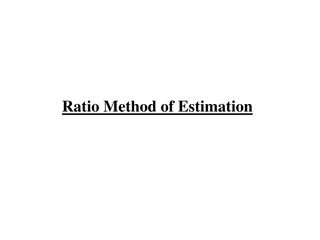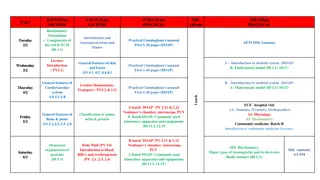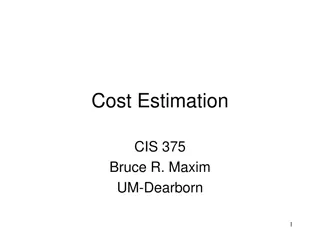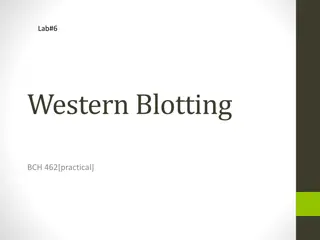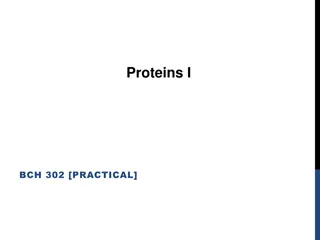Protein Estimation by Biuret Method in Biochemistry Practical
Protein estimation plays a vital role in various research applications. This practical guide covers the importance of determining protein concentration, specificity, sensitivity of methods, familiar spectrophotometric methods, standard curves, and determining unknown concentrations using Biuret method. The content includes informative visuals to aid in understanding the concepts and objectives of the practical.
Download Presentation

Please find below an Image/Link to download the presentation.
The content on the website is provided AS IS for your information and personal use only. It may not be sold, licensed, or shared on other websites without obtaining consent from the author. Download presentation by click this link. If you encounter any issues during the download, it is possible that the publisher has removed the file from their server.
E N D
Presentation Transcript
Quantitative Proteins Estimation by Biuret method BCH302 [Practical] 1
Importance of determining concentration of protein : Quantitative assays determine the concentration of a substance. Protein assays are one of the most widely used methods in life science research. Estimation of protein concentration is necessary in protein purification, cell biology, molecular biology and other research applications. Is necessary before processing protein samples for isolation, separation and analysis. 2
Specificity and Sensitivity of a method: Sensitivity of an assay is a measure of how little of the analyte the method can detect. Specificity of an assay relates to how good the assay is in discriminating between the requested analyte and interfering substances. 3
Most familiar spectrophotometric methods for Determination of proteins concentration : There are a wide variety of protein assays available, but each assay has its own advantages and limitations. Warburg Christian (A280/A260) Bicinchoninic acid method Biuret Lowry Bradford The factors that you should consider in choosing a method: Sensitivity. The presence of interfering substance. Time available of the assay. 4
Standard curve: It is a graph that shows the relationship between different known concentrations of a substance and the absorbance at a specific wave length. Standard curve are most commonly used to determine the concentration of a unknown substance, using serial dilution of solutions of known concentrations[standard solution], such as (Bovine serum Albumin) BSA and casein. There is a linear relationship between absorbance and concentration. 5
Determination of unknown concentration by standard curve: 6
Objectives: Determination of an unknown concentration for protein sample by Biuret method. Getting familiar with standard curve. 8
Biuret method: Principle: In this reaction, proteins form a purple colored complex with CuSO4 (copper sulfate) in a strongly alkaline solution. When peptide bonds in proteins and peptides treated with an alkaline solution of dilute copper sulfate (Biuret reagent ) a violet color is formed A positive test is indicated by the formation of a violet color. The color density is proportional to amount of proteins present. 9
From lower to higher concentration There is a linear relationship between purple colour developed and concentration. 10
Experiment 1 : Estimation of protein concentration by Biuret method Method: Set up 8 tubes as follows: Tube Water (ml) Bovine serum albumin Standard Concentration [5g/l] - sample [unknown concentration] Biuret reagent( ml ) Blank 2 - 1 1.6 0.4 - 2 1.2 0.8 - 3 1 1 - 4 0.8 1.2 - 3 5 0.6 1.4 - 6 0.4 1.6 - Unknown concentration sample - - 2 Let the tubes stand at room temperature for 10 min. Read absorbance at 540 nm against the blank. 12
Experiment 1 : Estimation of protein concentration by Biuret method Results: Tube Albumin concentration (mg/dl) [X- axis] Absorbance at 540nm [Y-axis] 1 C1 X V1 = C2 X V2 500 x 0.4 = ? x 2 2 3 4 5 6 Plot a standard curve for absorbance at 540 nm against Albumine std. concentration (mg/dl). From the standard curve find out the unknown protein concentration. 13
















